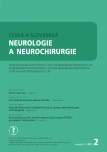The role of drug-induced sleep endoscopy for positive airway pressure titration – initial results
Authors:
M. Masárová 1,2; J. Seko 1; M. Plášek 1,2; M. Formánek 1,2; O. Jor 3; V. Novák 4; Pavel Komínek 1,2
; P. Matoušek 1,2
Authors‘ workplace:
Klinika otorinolaryngologie a chirurgie, hlavy a krku LF OU a FN Ostrava
1; Katedra kraniofaciálních oborů, LF OU, Ostrava
2; Klinika anesteziologie, resuscitace, a intenzivní medicíny FN Ostrava
3; Centrum pro poruchy spánku, a bdění – spánková laboratoř, Oddělení dětské neurologie, FN Ostrava
4
Published in:
Cesk Slov Neurol N 2021; 84/117(2): 183-187
Category:
Original Paper
doi:
https://doi.org/10.48095/cccsnn2021183
Overview
Aim: The aim of the work was to monitor the effect of positive airway pressure (PAP) on the particular sites of obstruction during the drug-induced sleep endoscopy to evaluate at which pressure the obstruction disappears/worsens and to clarify possible reasons for PAP intolerance. Materials and Methods: In the period from 6/2018 to 12/2020, a PAP test was performed during the drug-induced sleep endoscopy in 20 patients with obstructive sleep apnea without previous therapy. During the examination, sites of obstruction in the upper respiratory tract were identified. It was evaluated how the different pressure set during PAP ventilation reflects on the behaviour of the upper respiratory tract, and on its expansion or collapse leading to its obstruction. Monitoring was started at a pressure of 6 hPa, and gradually the pressure was increased stepwise by 2 hPa in the range from 6 to 18 hPa. Each pressure was applied for a minimum of 20 s. The findings were evaluated using the VOTE classification according to Kezirian and compared with each other. Results: The best effect of PAP was observed in the case of anteroposterior obstruction in the soft palate area, where the average opening pressure was 11.2 hPa. For laterolateral oropharyngeal obstruction, the average opening pressure was 12 hPa. PAP had no effect in 8/20 patients, 6 times due to concentric or laterolateral obstruction of the soft palate, and twice due to the collapse of the epiglottis. In the collapsing epiglottis, PAP ventilation does not relax the airways, because with increasing PAP pressure, the obstruction and suction of the epiglottis on the posterior wall of the pharynx worsens. Conclusion: Drug-induced sleep endoscopy of the upper airways with PAP is a simple and easy-to-perform examination which can reduce PAP intolerance (e.g., in the event of an epiglottis collapse) and thus optimize the treatment. We assume better compliance of the pressure device in patients who are indicated for this treatment.
Keywords:
drug-induced sleep endoscopy – obstructive sleep apnea – flexible endoscopy – positive airway pressure
Sources
1. Strollo PJ, Rogers RM. Obstructive sleep apnea. N Engl J Med 1996; 334(2): 99–104. doi: 10.1056/ NEJM19 9601113340207.
2. Cavaliere M, Russo F, Iemma M. Awake versus drug--induced sleep endoscopy: evaluation of airway obstruction in obstructive sleep apnea/ hypopnoea syndrome. Laryngoscope 2013; 123(9): 2315–2318. doi: 10.1002/ lary.23881.
3. Hybášková J, Jor O, Novák V et al. Možné využití spánkové endoskopie pro zvýšení efektivity léčby (operační i neoperační) u pacientu s obstrukční spánkovou apnoí. Cesk Slov Neurol N 2017; 80/ 113(4): 428–433. doi: 10.14735/ amcsnn2017428.
4. Weaver TE, Grunstein RR. Adherence to continuous positive airway pressure therapy the challenge to effective treatment. Proc Am Thorac Soc 2008; 5(2): 173–178. doi: 10.1513/ pats.200708-119MG.
5. Torre C, Liu SY, Kushida CA et al. Impact of continuous positive airway pressure in patients with obstructive sleep apnea during drug-induced sleep endoscopy. Clin Otolaryngol 2017; 42(6): 1218–1223. doi: 10.1111/ coa.12851.
6. Kezirian EJ, Hohenhorst W, de Vries N. Drug-induced sleep endoscopy: the VOTE classification. Eur Arch Otorhinolaryngol 2011; 268(8): 1233–1236. doi: 10.1007/ s00405-011-1633-8.
7. De Vito A, Carrasco LM, Vanni A et al. European position paper on drug-induced sedation endoscopy (DISE). Sleep Breath 2014; 18(3): 453–465. doi: 10.1007/ s11325-014-0989-6.
8. De Corso E, Fiorita A, Rizzotto G et al. The role of drug--induced sleep endoscopy in the diagnosis and management of obstructive sleep apnoea syndrome: our personal experience. Acta Otorhinolaryngol Ital 2013; 33(6): 405–413. doi: 10.1007/ s12070-017-1113-6.
9. Betka J, Klozar J, Kuchař et al. Léky navozená spánková endoskopie – cesta k lepším chirurgickým výsledkům při léčbě syndromu obstrukční spánkové apnoe. Cesk Slov Neurol N 2016; 79/ 112(5): 516–520.
10. Jung SH, Koo SK, Choi JW et al. Upper airway structural changes induced by CPAP in OSAS patients: a study using drug-induced sleep endoscopy. Eur Arch Otorhinolaryngol 2017; 274(1): 247–252. doi: 10.1007/ s00405-016-4233-9.
11. Schwab RJ, Pack AI, Gupta KB et al. Upper airway and soft tissue structural changes incuded by CPAP in normal subjects. Am J Respir Crit Care Med 1996; 154(4): 1106–1116. doi: 10.1164/ ajrccm.154.4.8887615.
12. Lan MC, Hsu YB, Lan MY et al. The predictive value of drug-induced sleep endoscopy for CPAP titration in OSA patients. Sleep Breath 2018; 22(4): 949–954. doi: 10.1007/ s11325-017-1600-8.
13. Lai CC, Friedman M, Lin HC et al. Clinical predictors of effectivecontinuous positive airway pressure in patients with obstructive sleep apnea/ hypopnea syndrome. Laryngoscope 2015; 125(8): 1983–1987. doi: 10.1002/ lary.25125.
14. Civelek S, Emre IE, Dizdar D et al. Comparison of conventional continuous positive airway pressure to continuous positive airway pressure titration performed with sleep endoscopy. Laryngoscope 2012; 122(3): 691–695. doi: 10.1002/ lary.22494.
15. Kezirian EJ, White DP, Malhotra A et al. Interrater reliability of drug-induced sleep endoscopy. Arch Otolaryngol Head Neck Surg 2010; 136(4): 393–397. doi: 10.1001/ archoto.2010.26.
16. Torre C, Camacho M, Liu SY et al. Epiglottis collapse in adult obstructive sleep apnea: a systematic review. Laryngoscope 2016; 126(2): 515–523. doi: 10.1002/ lary.25589.
Labels
Paediatric neurology Neurosurgery NeurologyArticle was published in
Czech and Slovak Neurology and Neurosurgery

2021 Issue 2
Most read in this issue
- Morton’s neuralgia, metatarsalgia
- Moyamoya disease
- Correct and incorrect naming of pictures for the more demanding written Picture Naming and Immediate Recall test (door PICNIR)
- Etiopathogenesis and diagnostics of progressive multifocal leukoencephalopathy in patients treated with natalizumab
